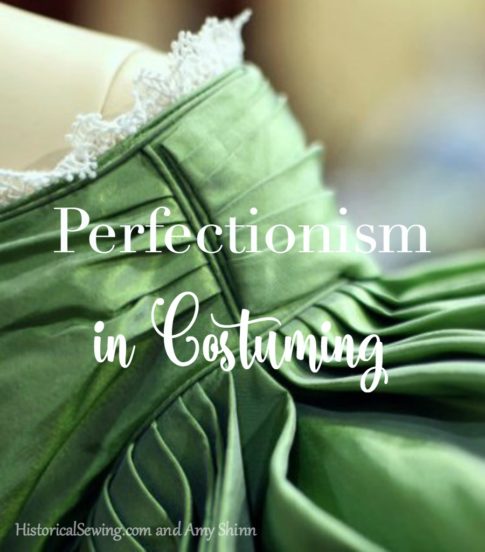
This post was first published in November 2017. With all the crazy happenings of 2020 and 2021 within our community I thought it good to take a look at this topic again.
Being perfect. What does that mean? When you strive for “perfect” you nearly always fall short of it. As one of my mentors once said, “it’s only after a project is complete that you can look back and say, ‘Wow! That came out perfect.'”
Perfect: having all the required or desirable elements, qualities, or characteristics; as good as it is possible to be; faultless; flawless; completely free from faults or defects.
Perfectionism: refusal to accept any standard short of perfection
When talking about a costuming project, perfectionism is overrated. I mean, we’re dealing with garments to wear. Clothing. Varying skill levels. Budget issues.
Somehow, in the modern historical costuming community being perfect has become a “thing,” especially recently.
That if, oh, dear, you are sewing at six stitches an inch it’s therefore wrong because it should be 10 per inch.
Or if you naturally look a particular way you shouldn’t be wearing XYZ styles.
Or because your husband got laid off leaving you with only a few bucks for a new dress and the poly taffeta is your best option…. and you are getting bashed for it….
Lately, and quite unfortunately, I’m hearing more of bullying in our costuming groups. This saddens me. And a lot of it stems from having a “holier than thou” attitude and bringing perfectionism into the conversation…. at least what perfection means to those people commenting about someone else’s work.
Listen, I’ve said for years that costuming keeps us dreaming and stomping on someone else’s dream and creativity is no way to advance the art and keep it alive.
Those of us who create historical garments have a variety of goals as distinct as each person in our small community. The path is different and varied for all. We connect to each other in the general sense of wanting to produce garments and accessories based on historical fashion. HOW we go about it, and to what level of detail, is what makes us different and colors this hobby in a myriad of ways.
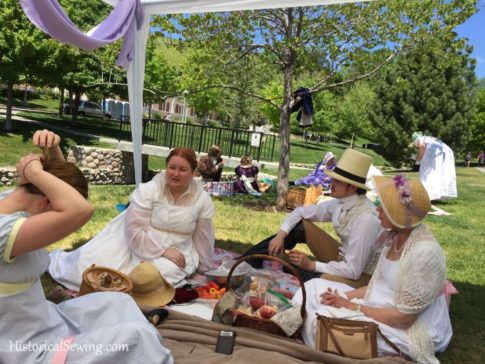
Some may only need a dress for the upcoming picnic so they don’t look out of place. They have no desire or need to wear it later.
Others want some historical accuracy but are restrained by time and/or budget considerations, so shortcuts are necessary.
Yet still others want to delve into the WHY behind the sewing techniques and methods used by our ancestors.
Then there are the scholars who not only want to research it all about a particular garment or era but also want to reproduce items as close as possible to the originals.
EACH AND EVERY ONE OF THESE VIEWPOINTS IS VALID AND NECESSARY IN OUR COMMUNITY. No one is wrong in their chosen path.
Your goal is different from mine. The why I do something is just as important as your why.
Every now and again our paths may cross to travel the same road in trying to achieve similar results. Yet, your path will vary greatly from mine. And this is not wrong. It’s what makes us individually unique and connect to our humanity.
But don’t bring your perfectionism into my world when you think I’m doing something that’s “not what they did.” Sure, there are good and bad choices, but that doesn’t make them incorrect when we are talking about a creative endeavor.
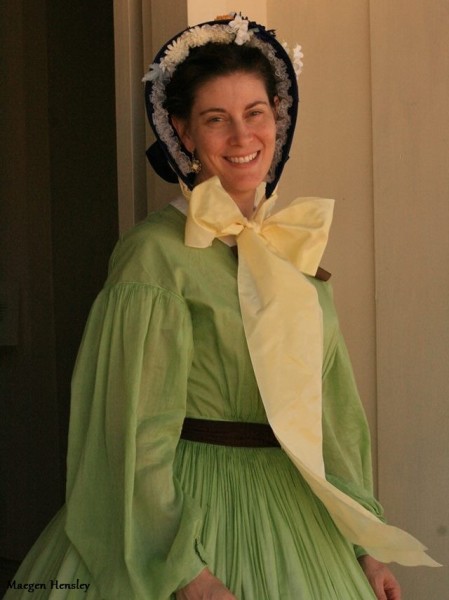
Historical costuming is creative from YOUR personal point of view. We each bring our modern, 21st century ideals and thoughts along with current skills and knowledge into each project we work on. We learn as we go. Our minds are opened to new ideas and methods as they are presented to us on our path.
It’s sad that one’s perfectionism – that turns into bullying – ignites the need to knock another’s creative work because they “know” how it’s supposed to be or look like when it could be that that other person is simply quite happy with their work.
There’s room for all of us in this sewing community. We NEED everyone here to share their knowledge, their works, their skills.
But don’t let it get to you if I don’t use your detailed research on how to make a Victorian bodice when I’ve found a better way – for me – in using other techniques. There’s no reason to bash my use of a serger because it’s not your perfect way of sewing Victorian garments.
Let’s keep “perfect” out of the conversation.
Allowing others the freedom to pursue their individual goals is thoughtful and caring. What makes this community Joyful.
In other words, let’s not push what we individually consider the “perfect” technique onto someone else. There’s many ways to produce results when re-creating historical clothing. Instead, let’s encourage others from where they are today on their journey!
Together we make this creative hobby fun and welcoming to newcomers. We are responsible for sharing and encouraging the next generation to take up where we have left off. And bullying has no place here.
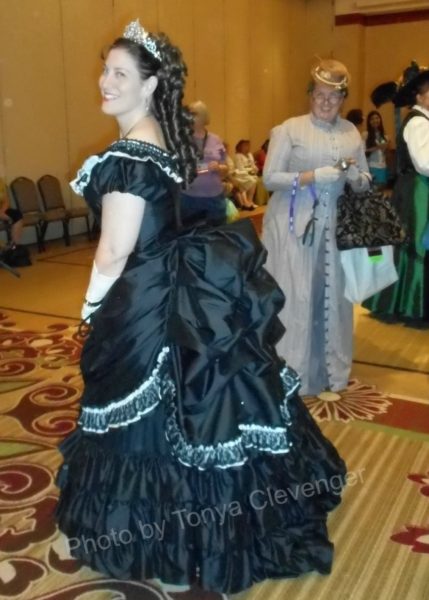
I’ll be frank and open. As someone who “wants the pretty dress” and teaches others the basics of historical sewing so they can have their pretty dress too, I will continue to move forward with promoting good things that come into our community that are beneficial to others – be it a book, a pattern, new research, a blog post, whatever.
I will support others’ creative projects that are based on historical fashion whether they are hand sewn stays, a machine embroidered Titanic gown, or a Steampunk wardrobe.
Plain and simple: I am not, primarily, a researcher, a scholar, or one who is trying to find out “exactly” how our ancestors made their clothing. I study originals enough to then use my talent of engineering to teach others how to do it. I don’t want to teach at the level of perfectionism. Because most people today don’t want to or don’t have time to make things exactly like they did.)
I want people to sew and make things! To create that pretty dress. To be inspired. Darn it all if it’s not historically accurate! That’s not the path I’m on. Life is too short.
However, you may be on that path – great! I’ll leave the detailed research to others and for those people who want to delve more into the studying I don’t care to do. To those who actually care about counting the stitches – which is still a super valid point of view.
As you move forward on your own journey be careful in thinking your research is the “be all and end all” way of making historical garments. THAT is the perfectionism I’m talking about. And we don’t need that here.
You do what you feel is the best for creative journey and I’ll follow my path. Together we can make the world a prettier place!
Cheers, my friends!
~Jennifer 🙂

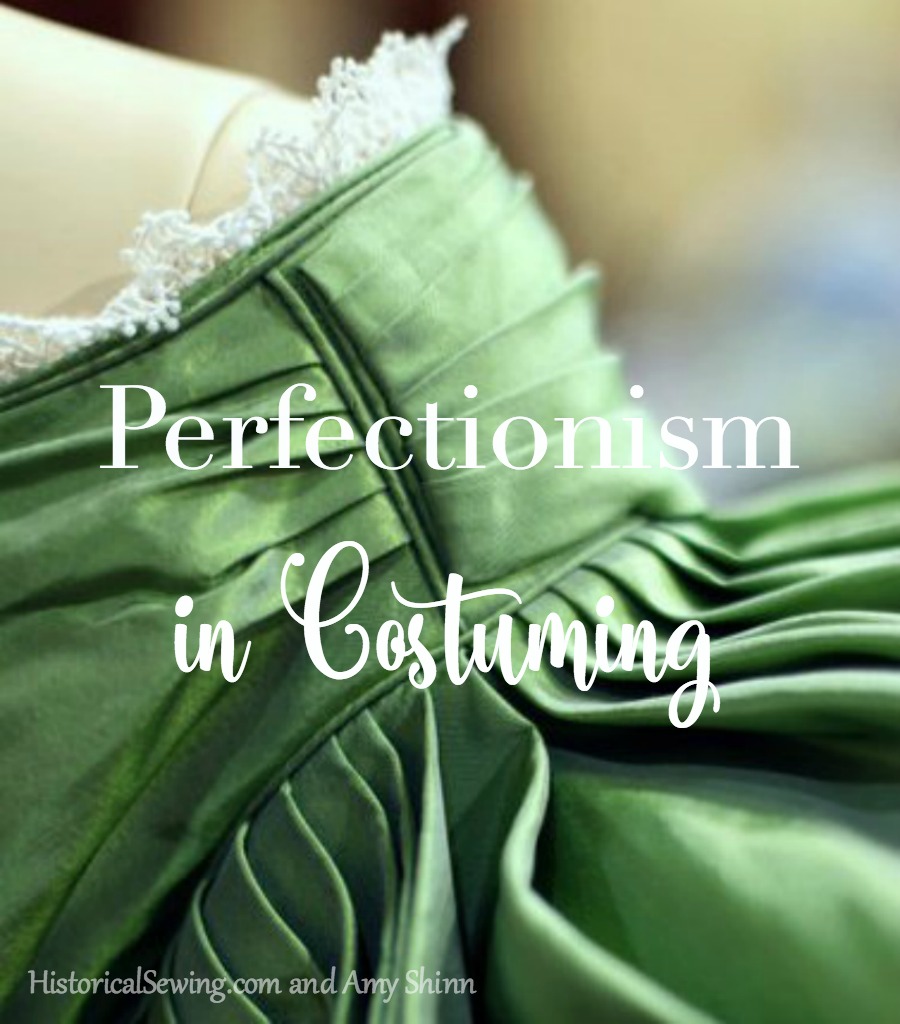
Thanks for this blog post! I’ve been paralyzed by perfectionism all winter. I have my pieces cut out to make my first set of 18thCentury stays…but I’ve been immobilized by fear of ‘doing it wrong’ by using zip ties and non-HA fabric. I planned to make them out of stash fabrics (canvas, muslin, quilting cotton) figuring they wouldn’t be seen anyway, but then I see all the lovely hand sewn, hand embroidered silk stays and just freeze up. Maybe today I just need to plunge in and get going. As my old French teacher would say– Plongé dans le piscine Jessica!
Quit holding yourself back. You can do it! Even with non-historically appropriate fabrics and zip ties. 🙂
Wonderful article. I’ve made two garments with the underpinnings now. I love them and am and just about to order silk for my next one. My first expensive fabric purchase. Being frugal, I used quilting cotton from my stash, muslin, and an old flat sheet for my first bustle dress. Only thing I bought for the first was stiff organdy for the petticoats.
While trying for accuracy in the design, I came up against time needing to have the garment done for an event. Not wanting to make 12 buttonholes, I dug into a drawer and came up with a roll of snap tape I used to make baby and toddler garments for my boys.. The oldest is 38. What a wonderful invention. I sewed that sucker to the bodice, sewed the buttons on and no one knew the difference. Purists might criticize me but my garment was done and I wore it proudly.
I did the same with the pigeon breast blouse. Made it much easier to put on by myself as I dressed for a wedding. The skirt was polyester plaid I got on clearance at Joann’s.
I’m all for being accurate, to a point, but not all of us are as interested in historical accuracy or care as much. Practical aspects of being able to finish the garment on time or dressing by yourself can play into how “accurate” a garment is. Serging for flatlining and petticoat seams saves so much time and finishes the edges. Don’t think that, if they could afford one, women didn’t purchase a sewing machine as soon as possible. They didn’t worry that the clothing they made for their families “wouldn’t be accurate” because they were not hand sewn.
I love my garments and will be making more. I can guarantee they will have snap tape in the bodice and (Oh horrors) may have zippers because I don’t really like my skirt coming undone because the hooks came undone. Oh, I used hook and eye tape on that skirt. Much easier to sew on using a sewing machine rather than each one by hand. Shhh, don’t tell anyone, but I have industrial zip ties as my corset “bones.”
It might be helpful, if you are worried about being “authentic” when it’s beyond your means or ability, to If you ask yourself if people would have used this material or technique if it had been available at the time! Don’t tell me they wouldn’t have made good use of zippers or sergers if they had had them. If you need to adapt historical styles with modern anachronisms for easier on and off or affordability, don’t let the history curmudgeons get you down!
Hello
Please forgive my intrusion into your sewing forum. I’m not really a sewer, I’m more into social history and aspects of clothing.
I’ve found a movie of 1899 ladies on bicycles…..and clearly all are in corsets.
Thank you for your giving me a little of your time and space.
Mintie
A bit of a side note but I have a quick question! I recently finished my first ever Victorian corset (yeah!) and it fits wonderfully but I have been having some pain in my lower back. I think it is the way I am sitting in my corset. What can I do to make my corset more comfortable, could it be a fit issue? Thank you so much and I love your blog, it is so very helpful! 🙂
Yes, a modern slouch continuing while wearing a corset can make for pain in the lower back. I experience it too. Could be that the waistline of the corset is not truly matching yours on your particular figure. This is probably a fit issue around your hip bone.
And thanks for reading!
You have so eloquently expressed my philosophy! Thank you for sharing. I use my server for flat lining because I like the finish. Many of my fabrics are synthetics that look and feel correct due to budget issues. I would love love to make gowns of 100% will but cannot justify the cost. I love your accepting philosophy.
Jennifer, Jennifer, God bless you for your comments. And the other commenters, too! I so appreciate the scholars and accurate seamstresses, love reading their stuff, but — I just wanna go make another pretty!! Maybe one day I’ll have time to make more of my stuff from scratch. But right now I enjoy “thrifting” and putting stuff together to make historical repros — representations? facsimiles? what to call?? In fact I’m about to launch a course in doing that: making Edwardian outfits from thrift store finds. I have a little trepidation about telling people to do that; but from the feedback I get, I’m pretty successful. And it’s fast, and cheap, and if that’s a help to someone, I’m happy to share my experience! I hope there is room for ALL stripes of costuming, ’cause I know there’s just a lot of talent and inspiration out there and I get inspired seeing it all.
Amen and Bless you! Unfortunately I have been on both sides of this problem; thinking I was doing the right thing in pointing out flaws. Yes, I was stupid. And I’m working on keeping my wrong opinions to myself. You are very right in that the why is more important than the what in costuming. I am hoping to continue learning that. Merry Christmas.
Thanks for this thoughtful and encouraging post! I try to remember that those who feel the need to put others down may suffer from insecurity – the only way they know to make themselves feel better is to feel superior to someone else. That helps me feel sorry for them instead of feeling put down. But it’s easier said than done!
Beautifully said, Jennifer, and right on target. Thanks so much for posting this. I’m off to share it on Facebook! 🙂
Jennifer, thanks so much for writing this post! I’m fairly new to historical costuming but am an established quilter and have been sewing since I was small. Unfortunately, we see some of the same “perfectionism” and bullying in the quilting world. (We even have a name for them: the quilt police! )
I appreciate folks with high standards and really enjoy learning about things from the perspective of historical accuracy. But I think it’s important to respect where people are coming from, re: budget/ time constraints, unhoned research or sewing skills, etc.
Inclusiveness means welcoming people who have a desire to participate, regardless of what they are bringing to the table. Unfortunately, I think sometimes folks tie their identity and ego to their craft and feel threatened by the entry of newbies.
Whether it’s costuming or quilting, it’s important to remember that we’re all in it for enjoyment, regardless of whether it’s a hobby or profession!
THANK YOU! THANK YOU! This came at the most appropriate time ever!
Great article. If a certain group has a reputation of being full of “stitch counters”, I won’t join it. I’m here to dress up and have fun. As a docent, I have to get as close as possible to the historical accuracy and I sew for the group, but no way am I making six Victorian shirts and 5 pairs of pants for for the costume vault without using a machine!!!
I hate bullying of any kind. I you bully me I’ll avoid you forever (and you’ll be missing out big-time). If you bully someone else, I will immediately befriend them. Bullies beware – no one likes you. At ALL. EVER. So just stop.
Excellent article Jennifer. I must admit I am a firm believer in ‘if you can’t do it properly, don’t do it at all’ but I would NEVER tell anyone this. Besides, I’ve made some stupid mistakes with my Victorian (especially) clothing but learn with each mistake and try VERY hard not to pass on these mistakes to my unsuspecting clients!! 🙂
I must also admit that I would have taken that museum tour guide aside and had a nice quiet chat with her as I am a FIRM believer in feedback (but not the rude kind)
Your attitude is “perfect” in regard to any kind of costuming. Thanks for sharing.
As usual, your article is great. I volunteer at Sutter’s Fort State Historical Park. We are responsible for our own clothing since it is a State Park and cannot afford to clothe us. We try to be as close as we can, but we understand the limitations involved. We do mainly 3rd person interpretation so it is important to get the information out to the visitors. We do place some limits but not very many. If someone wants to use a machine to make their clothing, fine. We ask any visible stitching (top stitching, buttonholes, hems) be done by hand if possible. We are there to have fun and talk to the public about the Fort. We have had the stitch counters in our docent group, but they are few and far between. We have a small committee of docents who monitor and help with the clothing aspect. We make suggestions to make things easier and look better.
I have seen some of the bullying that goes on and it makes me angry. Everyone has to start somewhere so be helpful instead of hurtful.
Thank you again for a wonderful article. Have a very Merry Christmas and Happy New Year.
I have taken class trips to Sutters Fort and can tell you, the children are not stitch counters. They are far more interested in the fact that a woman might only have 2 dresses and everything had to be washed by hand. They were shocked at the amount of work that went into getting clothes clean! The washing, starching and ironing that required heavy labor was horrifying to them. Thank you for the education you provided our kids.
Thanks so much for this post! I worked for a time in an incredibly cash-strapped historical museum(aren’t they all?) where “interpreters” often had to go from full costume to puppeteer blacks in less than 5 minutes. Yeah, weird, but so fun! As a result, my main dress for the 1830s had a big old zipper up the back. Reenact-ors from other sites could be downright mean about the inaccuracy, but I found most “ordinary” visitors were too focused on how beautiful the dress fabric was. Ditto the costume pieces my husband and I wear for renaissance faires: not accurate, but as pretty as I could make them and we always get lots of compliments! Life’s too short to be judgmental. I find that critics can be quieted with a calm, “I am merely representing this period, obviously I’m not old enough to actually be from the era. Are you?” 🙂
hehe…
I will admit when at a museum that I expect interpreters to be accurately dress and find that zipper I am shocked. It’s something I am working on… being graceful and accepting of their limitations (budget, time, resources).
Funny story: Years ago a group of us was having a 1870s bustle picnic on a museum site and we got a free tour of the exhibits (small but fabulous articles). We, of course, were in our full getups with undergarments, corsets, petticoats, dresses and accessories. The kind interpreter (can’t remember if she was in “old-timey” clothes or merely nice blouse and skirt) was pointing out a display of corsets and said, “The ladies would put their corsets on and then they fainted.” Clear as day comment… completely not realizing that the group of a dozen or more ladies standing listening to her were wearing proper Victorian corsets. Our eyes all got big but we didn’t say anything to her. She was kind but obviously not knowing the truth. So it comes to everyone being on a different journey and on different points on that journey. We are learning as we go.
Jennifer, thank you for speaking up about this issue. I agree with you that those who judge others as being inferior are out of line. We should all be helping each other learn and grow in the art of costuming, not criticizing or belittling. You continue to help others through your classes and encouragment. I appreciate that.
Thank you. I needed to hear this-not because I’m sewing historical clothing but because I struggle with self-imposed perfectionism every day. It sucks the absolute joy from everything I make. All I see are the stitches that are crooked or top stitching that went a stitch or two past where it should be. Or the couple of places where my hand stitching can be seen. I see the place where the facing has rolled forward and this side doesn’t hang quite right. Stripes that don’t match, or wishing the thread was a shade darker or lighter. I don’t even want to start with the issues concerning fit, because that’s another struggle for me. I focus on every little thing I see as imperfect and therefore wrong. And I quit sewing. There is a little monster who lives inside my head. His name is Perfectionism…and I really don’t need others to feed him.
Throw that thing out the window, give yourself grace, and look for the simple joys as you sew. And remember, you are not alone in being a perfectionist. 🙂
Your monster has a relative in Australia, who lives in my head. Starve him out…keep making and forgiving yourself. My new motto is, you want it “better”, off you go and make it yourself.
I so get where you’re coming from. I was born a perfectionist. Ungraceful perfectionism makes life SO much harder. I eventually recognized what I was doing, to both myself and others. I didn’t mean to cut people down, but that was the actual effect of my ‘help.’
I have decided that transforming the ungraceful perfectionism into forgiving perfectionism and applying it mostly to myself instead of others is much more helpful, both for me and for the people who have to live with me!
It took years for me to believe that most people will never, ever notice the (to me glaring) mistakes in my creations.
For all you people out there who are not perfectionists: next time someone nitpicks/ criticizes you or something you made, consider that maybe the person is just as critical of themself as they are of you, and that they may not even realize how negative their comments are! Try complimenting their outfit or even asking for advice; their response might tell you a lot about their perspective and intentions. I’m sure some perfectionists are pleased to think mean thoughts about others, but many of us could use some encouragement.
Thank you Jennifer for sharing your thoughts. For a few years I made 19th century costumes for SASS Cowboy Action Shooting. Basically we dressed up and played cowboys and ladies in hoop skirts. It was great fun and some more accurate than others. As time went along, a group of ladies had the budget, time, and talent to make outstandingly beautiful gowns. But along with that came ladies making comments that others gowns just didn’t measure up causing hurt feelings and some ladies just quit making gowns. As several others commented above, its just common sense that seamstresses in past centuries took short cuts, used what was available and worked. Recycled clothing was a given back then in most any century. I just want to dress up, be as accurate as I can and pretend I;m living in the century I should have been born in.
Thank you!
Balance and respect for one another serve us well.
The need to be the “most right” rarely does.
I love that article! See, I’m in historical sewing because I love some of the fashion styles, the silhouette lines, the overall shapes and decoration achieved. But – and this is a huge point for me – I hate most of the fabrics they used. I like simple, modern designs. So I’m trying to do both – historical shapes with modern fabrics. Not unlike some of the Haute Couture designers – getting inspired from the past but still moving forward…
I’m a fan of “twisted historical” or rather, making historical ensembles in fun, modern prints and colors. 😉
Thank you for this. I see and hear the fabric and stitch Nazis all the time. I always try to use natural fibers but since I am a larger women 10 plus yards can get pricey. I get the historically correct thing, but we can’t be rude or berate someones attempt simply because WE don’t like it. THANK you so much for posting this and shining a light on a ugly topic.
Jennifer, I want to thank you for this. When I first started costuming for re-enactment I made many mistakes. Over time I learned more and spent more and got better. Now I think I’m a pretty good costumer. I owe many thanks to people who taught me and encouraged me and still have grudges against people who criticized my work as not “historically accurate”. Some of the comments I’ve heard have made me cringe. You have said what I have thought many times. Being snarky to someone is so very unkind. When did we, as a community, make it OK to be rude and unkind? Well, we haven’t. Trust me, the bad manners we have all observed would never be considered “historically accurate”. You have said what I have felt only you did it so much better than I ever could.